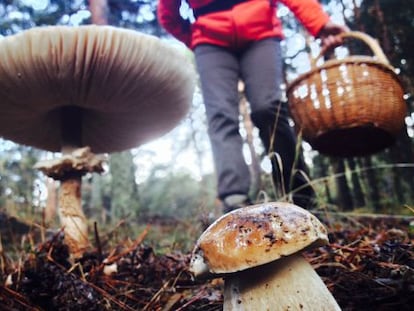15 forests for feeling the fall in Spain
Catch the spectacular sights of autumn in woods from the Atlantic to the Pyrenees
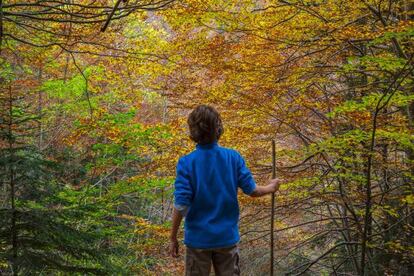
From the Atlantic to the Pyrenees, much of northern and western Spain is home to spectacular forests, and the fall is a great time to visit them. Whether you travel alone, with a partner, the family, or join a guided tour, it’s well worth taking at least a couple of days to get to know this country’s woodlands.
Bosque de Orgi (Navarre)
At the southern end of the Ultzama Valley, just 25 kilometers from Pamplona, lies the ancient oak forest of Orgi, which has plenty of walking routes and up to 15 species of bat. Nearby is Lekunberri, the starting point for the Plazaola Greenway, which follows the former train line between Pamplona and San Sebastián.
Getting there: From Pamplona, take the N-121 north to Ostiz, then take the NA-411 to Lizaso. The drive takes around 40 minutes.

Muniellos and Redes (Asturias)
Muniellos has one of the largest and best-preserved oak forests in Europe. At this time of year, there is an eye-catching contrast between the mighty oaks, the green of the birch and the ochre and red hues of the beech, chestnut and rowan. The thick forests of Redes, which are a UNESCO biosphere site, are an essential part of fall in this northern region.
Getting there: From Cangas del Narcea, take the AS-15 to Ventanueva. From there, take the AS-11 for two kilometers to Moal. A four-kilometer path leads to Tablizas, where the Muniellos forest begins. To visit the reserve, a permit is required, which can be downloaded from the Principality of Asturias website: www.asturias.es.
Hayedo de la Pedrosa (Segovia)
Just 150 kilometers from Madrid, the woodlands in the Ayllón hills, in the northeastern corner of Segovia province, are ablaze with the colors of fall. One of the southernmost beech forests in Europe, La Pedrosa provides the backdrop for a pleasant walk, not only through beech, but also oak, birch, rowan and hawthorn up to La Quesera pass. A visit to the area should also include Riaza, the starting point for a visit to the villages of Alquité, Madriguera, Villacorta, Martín Muñoz and Becerril, where the colors of the woodland provide a counterpoint to the clay and slate architecture of these communities.
Getting there: Head out of Madrid along the A-1, then take exit 103 toward Riaza on the N110.
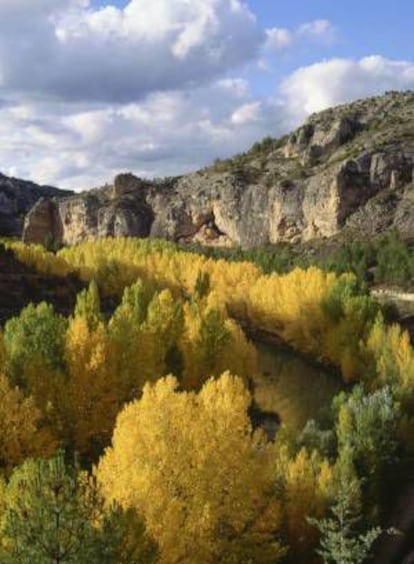
Hoces del Júcar (Albacete and Cuenca)
During its journey through Albacete province, the Júcar river plunges through deep canyons and down rocky outcrops, creating one of Castilla-La Mancha’s most spectacular landscapes. Nestled among the woodlands and hills are small communities such as Alcalá del Júcar, a spectacular fortress town whose whitewashed houses seem to cling to the rocky hillside, in contrast with the intense yellow of the clusters of poplars down by the river.
Getting there: From Madrid, take the A-3 to exit 237.
www.turismocastillalamancha.es
Fageda de la Grevolosa (Girona)
Some of the beeches in this forest on the edge of the Garrotxa Volcanic Zone Natural Park, in the foothills of the Pyrenees, are over 200 years old, and have grown to heights of over 30 meters.
Getting there: Take the C-37 from either Vic or Olot, and then turn off to Bracons until Sant Andreu de la Vola.
Comarca de los Cuatro Valles (León)
The four districts of Omaña, Luna, Babia and Laciana in León have been declared a UNESCO biosphere reserve. The region lies at the crossroads of ancient trade and pasture routes, and is heavily wooded with oak, birch, beech, holly and maple.
Getting there: Head out of Asturias or León via the A-66, taking the Villblino exit, and then the CL-623.
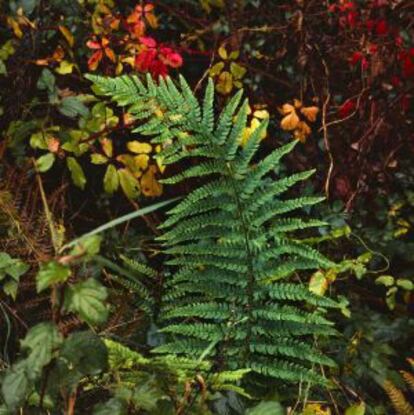
Gorbea and the Aralar mountains (Bizkaia, Gipuzkoa and Navarre)
In the heart of Goierri, the limestone Aralar mountains, dotted with cave systems, run between Gipuzkoa and Navarre, creating a magical landscape that is home to the Akaitz beech forest, the limestone pavement of Pardarri, the Arritzaga valley, and the glacial cirque of Pardelutz. More than 100 dolmen, burial mounds and menhirs are scattered throughout the valleys, while on the rich grassland of the Txindoki mountain, shepherds graze their latxa sheep, whose milk is used to make the area’s best-known cheese, Idiazábal.
Getting there: From Pamplona, take the AP-15 to Lekunberri, and then continue on the NA-7510.
Cañón de Añisclo (Huesca)
Close to the San Urbez hermitage is this impressive waterfall created by the Vellós river in the Añisclo canyon, one of four valleys (Ordesa Añisclo, Pineta and Escuaín) that make up the Ordesa and Monte Perdido National Park in Huesca. In fall its beech, birch, maple and ash trees create a riot of reds and yellows.
Getting there: From Sabiñánigo, take the N-260 to Broto and Torla.
Valle del Ambroz (Cáceres)
Deep in the northern part of Cáceres, between Las Hurdes, a region that was once a byword for rural backwardness, and the Jerte Valley, famous for its spring cherry blossom, lies the greener than green Ambroz valley. South facing, it has a mild climate tempered by Atlantic rains, which has created immense woodlands of chestnut and oak. One of the best examples can be found close to the historic town of Hervás, on the road leading to Cabezuela del Valle.
Getting there: Head out of Salamanca via the A-66 or the N-630.
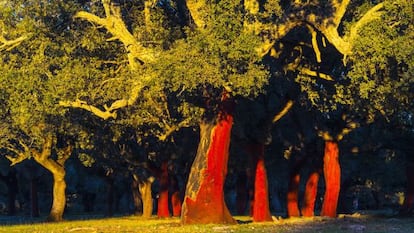
Fraga de Catasós (Pontevedra)
The interior of Galicia’s Pontevedra province is still largely unknown, so take the opportunity to visit this natural treasure trove. Around 50 kilometers from Santiago de Compostela, close to the tiny community of Lalín, is the Fraga de Catasós, a forest containing some of Spain’s oldest chestnut trees.
Getting there: Take the AP-53 from either Santiago de Compostela or Ourense.
Urbasa Natural Park (Navarre)
The turning of the beech trees in Urbasa is one of the most impressive sights in Spain each fall.
Getting there: Urbasa can only be reached on foot from Baquedano along a footpath to the Urederra river. The walk takes around 90 minutes. To reach Baquedano by car, take the NA-718 Estella-Olazti/Olazagutía, and then the NA-7187 after 13.8 kilometers.
Fuentes Carrionas (Palencia)
The foothills at the western edge of the Cantabrian mountain range are carpeted with dense woodlands made up of chestnut, beech, holly and different oak species. This area in northern León is one of the last reserves of the European brown bear.
Getting there: From Palencia, take the A-67 to exit 80 and continue on the P227 to Cervera de Pisuerga. From there, take the P-210 to the Polentinos road.
Sierra de Cameros (La Rioja)
One of the best-preserved areas in this famous wine-producing region, Cameros was once a major migratory herding route, and many signs, such as refuges and corrals, can still be found in the forests here. Fall is the ideal time to explore the area.
Getting there: Take the N111 between Logroño and Soria, passing through the Iregua valley.
Selva de Oza (Huesca)
The western valleys of the Alto Aragón (Hecho, Anso, Aragües del Puerto, Borau and Aísa) in La Jacetania (Huesca) conceal some of the largest forests in the Pyrenees. One of the most spectacular ones to visit in the fall is Selva de Oza, made up mainly of beech and fir, and where dolmens, menhirs and stone circles are a testament to the megalithic culture that once thrived here.
Getting there: From Huesca, take the A-132 to Puente la Reina, and then the A-176 to the village of Siresa.
Fraga do Eume (Coruña)
The largest forest in Galicia, the Fraga do Eume, runs along the valley of the river Eume, providing a home to local species of oak, chestnut, birch, ferns and ash, as well as animal species such as the long-tailed salamander.
Getting there: Take the AP-9 from A Coruña to exit 21F, then head to Pontedeume. From there, take the AC-564 to Caaveiro. Around 54 kilometers in all.
English version by Susana Urra.
Tu suscripción se está usando en otro dispositivo
¿Quieres añadir otro usuario a tu suscripción?
Si continúas leyendo en este dispositivo, no se podrá leer en el otro.
FlechaTu suscripción se está usando en otro dispositivo y solo puedes acceder a EL PAÍS desde un dispositivo a la vez.
Si quieres compartir tu cuenta, cambia tu suscripción a la modalidad Premium, así podrás añadir otro usuario. Cada uno accederá con su propia cuenta de email, lo que os permitirá personalizar vuestra experiencia en EL PAÍS.
¿Tienes una suscripción de empresa? Accede aquí para contratar más cuentas.
En el caso de no saber quién está usando tu cuenta, te recomendamos cambiar tu contraseña aquí.
Si decides continuar compartiendo tu cuenta, este mensaje se mostrará en tu dispositivo y en el de la otra persona que está usando tu cuenta de forma indefinida, afectando a tu experiencia de lectura. Puedes consultar aquí los términos y condiciones de la suscripción digital.
More information
Archived In
Últimas noticias
Half of Scotland is in the hands of 420 property owners
Reinhard Genzel, Nobel laureate in physics: ‘One-minute videos will never give you the truth’
Pinochet’s victims grapple with José Antonio Kast’s rise in Chile
From digital curfews to blocking apps: How technology experts protect their children online
Most viewed
- Pablo Escobar’s hippos: A serious environmental problem, 40 years on
- Reinhard Genzel, Nobel laureate in physics: ‘One-minute videos will never give you the truth’
- Why we lost the habit of sleeping in two segments and how that changed our sense of time
- Charles Dubouloz, mountaineering star, retires at 36 with a farewell tour inspired by Walter Bonatti
- The Florida Keys tourist paradise is besieged by immigration agents: ‘We’ve never seen anything like this’

